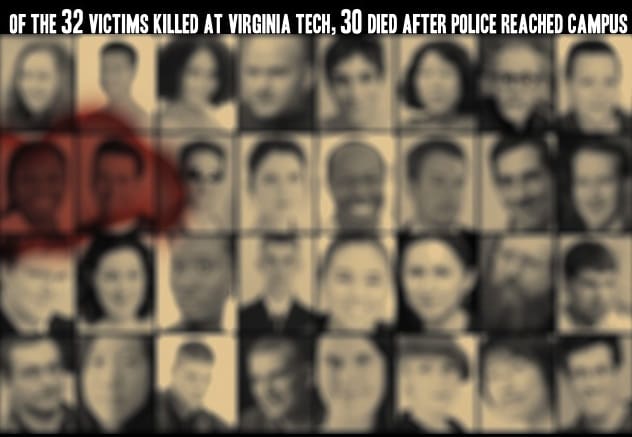Hoplaphobics (people who suffer from an irrational, morbid fear of guns) tend to use the same arguments against armed self-defense. Here’s one: “Guns in private hands add more danger to an already dangerous situation. Violence only begets more violence.” Front Site founder Jeff Cooper addressed this issue succinctly: “It is my earnest endeavor to see that it does. I would like very much to ensure – and in some cases I have – that any man who offers violence to his fellow citizen begets a whole lot more in return than he can enjoy.”
Cooper knew of the truth about the nature of aggression. He was right to tell the world that wrongful violence, or the threat of violence by criminals, should be quickly met with as much violence as can possibly be brought to bear.
“But doesn’t that put US on THEIR level?”
Not at all.
While the action of shooting a bullet seems mechanically appear similar, the motivation and recourse are as different as making love to one’s spouse and rape. Or an automotive accident and first degree murder. For example, a criminal can fully intend to drive a truck through the front window of a restaurant and kill as many innocent diners as he can.
In fact, imagine that scenario. And suppose the criminal emerges from his truck fully intending to assassinate as many survivors as possible. Wouldn’t you want someone in the restaurant to have a gun so that he or she could shoot the driver?
“But what if there had been an armed dinner, but he was the first one killed in the attack?”
Then the other diners would have been no worse-off for his having being armed. And the more armed diners there were, the greater the chances that one of them would have survived to defend their life and the life of those around them.
“But what if there had been armed diners in that scenario and they exchanged gunfire with the criminal? Bullets would have been flying all over the place. The carnage would have been worse! And when the police arrived, how would they know which armed man (men, woman or women) were the ‘bad guy’ and which was the ‘good guy’?”
Like many arguments used by gun control advocates, these ideas are based on “common sense.” But instead of using theoretical “what ifs” to gauge reasonable behavior in a life-or-death situation; let’s look at some real world examples.
Those of you who know your firearms history will have already recognized the scenario above. October 16, 1991. Luby’s Cafeteria. Killeen, Texas. [Click here to read Suzanna Hupp’s account of the massacre]. One gunman. No armed customers. Killed and seriously injured (KSI): 23 patrons murdered, 20 injured.
Two months later. December 17, 1991. Shoney’s Family Restaurant. Anniston, Alabama. Three gunmen. Twenty hostages (held in a walk-in cooler). One armed customer (Thomas Glenn Terry). KSI: one dead robber, one wounded robber. No civilians harmed.
January 16, 2002. Virginia Appalachian School of Law. One gunman. Two armed students. KSI: three innocents murdered, three injured.
April 16, 2007. Virginia Tech. One gunman. No armed civilians. KSI: 32 murdered, 25 injured.
October 1, 1997. Pearl High School, Mississippi. One gunman. One armed civilian (Vice Principal). KSI: two murdered, 7 injured.
April 20, 1999. Columbine, Colorado. Two gunmen. KSI: 13 murdered, 24 injured.
I chose these samples based on their similarity, with the main variable being an armed civilian. There’s plenty of ways to dispute this comparison, but “common sense” says it’s a valid analysis. Anyway, let’s do the math . . .
Defenseless victims within a “gun-free zone”: 68 murdered, 69 injured. KSIs where the murderers encountered armed resistance: five murdered, 10 injured. Time and time again, when a civilian is armed in a violent public situation, he, she or them can at least limit the carnage. Time and time again, when they’re not, the police arrive too late to stop the killing.
“That still doesn’t answer ‘how would the police know which armed man (men) was the ‘bad guy’ and which was the ‘good guy’?!”
In the above examples: When the police finally arrived, the people with the guns were the good guys. Somehow, the Second Responders managed to not kill the wrong person. Equally, I can’t find an example of a crime scene involving mass murder—or potential mass murder—where an armed intended victim “made things worse.”
To quote Colonel Cooper, “An unarmed man can only flee from evil, and evil is not overcome by fleeing from it.”





“…I can’t find an example of a crime scene involving mass murder—or potential mass murder—where an armed intended victim “made things worse.”
That quote reminded me about how amazing it is that so many people seem to be completely unable to grasp this concept: Yes, accidents do happen, and yes, it’s extremely unlikely that accidents involving firearms could ever improve any situation. However, to automatically assume that “the carnage would have been worse” if any armed citizens had made an attempt to handle the situation is so very naive.
Sure, there’s always the potential for the armed citizen to miss his/her target and end up hitting an innocent bystander, but that’s why it’s completely irresponsible to take a shot unless you’re sure of your background (one of the Commandments of safe firearm handling). A responsibly armed citizen wouldn’t just start popping off rounds without first assessing the situation and making a decision to produce an armed response, if appropriate.
I also strongly advocate the importance of training and practice if one makes the choice to arm themselves, because being a pretty accurate shooter, at both stationary and moving targets, sure isn’t going to hurt your chances at producing an effective armed response.
Comments are closed.